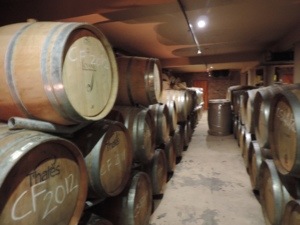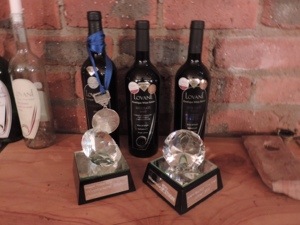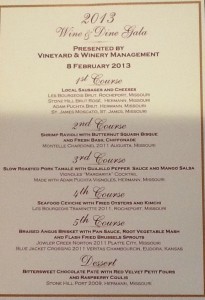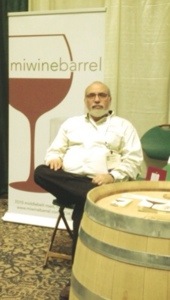
Posts in Blog, Latest News Category
Dispatches From Cape Town – The Wine Tour
One of the many things we were looking forwarded to on our trip to Cape Town South Africa was to sample some of the South African wines we had heard so much about. On a professional level, I was curious as to whether the South African Wineries were using wooden or stainless steel barrels, large tanks or other processes. What I learned was both unexpected and exciting.
Our first winery visit was to Groot Constantia, the oldest winery in South Africa. It was established in 1685 by Simon van der Stel, then governor of the Cape. The farm changed hands many times until it was made famous by the Cloete family in the 1800’s. Their wines would be admired by many famous people, including Napoleon, Bismarck, King Louis Philippe of France, and Jane Austen. In 1885 Groot Constantia was purchased by the government of the cape. In 1993 ownership was taken by the Groot Constantia Trust. Today, it hosts two popular restaurants, a wine tasting room and is known for its production of high-quality red wines, including Shiraz, Merlot and blended red Gouverneurs Reserve.
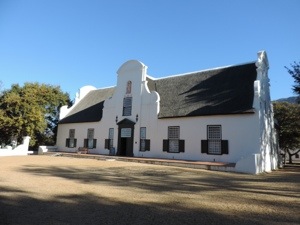
The Goot Constantia Manor House
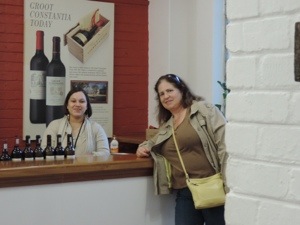
Gail and our host in the Groot Constantia Tasting Room
Although pressed for time, we managed to taste several excellent wines and purchased a fine Chardonay.
The next day Gail, Michelle and I went on an “Wine Safari” organized by Wine Flies. We were picked up near our apartment by our guide, Lord G (the G man) and after several other stops to pick up other tour members were on our way to several wineries in the Stellenbosch and Paarl areas. We were all given hats to wear so we could tell our tour apart from the others.

Lord G, Rick and the Wine Flies Van
Our first stop was Fairview Estate in Paarl. It is a family farm know for its excellent white wines and artisanal cheeses. The farm has been around since 1683, and was purchased by it’s current owners, the Back family, in 1937. The tasting room was modern and light. The wines and cheeses were presented paired together and were both excellent. They used large modern stainless steel tanks to make their wine and the sales room was wonderfully designed.
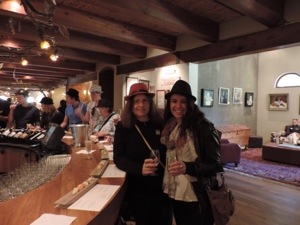
Gail and Michelle in the Fairview Tasting Room

Stainless Steel Tanks at the Fairview Estate
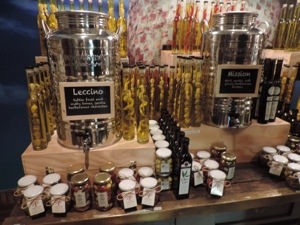
One of the Sales Displays at Fairview Estates
Next we were off to Muratie, an estate that started in 1685. Here I received my first surprise. The wine tasting rooms are in the cement vats that used to be used to make wine. I thought that the use of cement for wine making was a recent innovation, but it turns out that the Romans were using cement vats for winemaking over 2000 years ago.
Interestingly, Muratie’s cement vats use much of the same tri-clover and quick release stainless steel fittings that miwinbarrel uses on our stainless steel wine drums and tanks.

Fittings and Access Cement Vat at Muratie
After Muratie we were off to lunch at Middelvlei Wine Estate for a lunch of Boerekosbordjie (plate of farmer’s food) consisting of home-made bobotie, freshly baked potbrood, Ben’s snoek pâtè, grape salad with a red wine vinaigrette, coffee, koeksisters. It was delicious, served outdoors, in a beautiful setting.
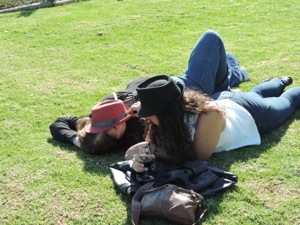
Gail and Michelle relaxing after lunch
Then we were off to LovanE Boutique Wine Estate, one of the smallest wine estates in the Stellenbosch area. Although they only started producing wines in 2006, they have won several awards. As a boutique winery, they use only oak barrels, most of them from France.

Gail and Michelle in LovanE’s Tasting Room
Our final stop was Annandale a wine estate that is owned by Gerhard (Hempies) du Toit, a fifth generation South African Huguenot winemaker who traces his winemaking heritage back to the founding of South Africa. He also was a famous Springbok Rugby player. Although he purchased the estate in 1996, Annandale’s history goes back over 315 years. The farm and tasting room reflect both the history of the farm and its owner’s with antique wine making equipment and sports memorobilia.
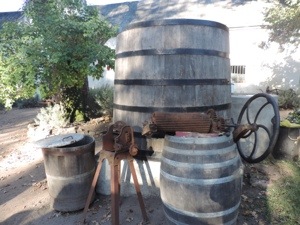
Old wine equipment at Annandale
Annadale uses mostly french oak barrels, but unlike many wineries they keep their wine in barrels up to 92 months.
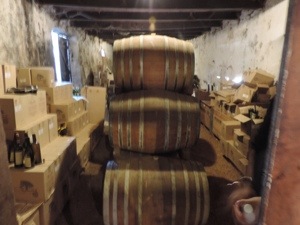
The result was exceptionally rich and flavorful wines. The former Springbok’s estate has won nine awards world-wide including the Grand Prix d’Honneur award in 1993 at a wine expo in France. Annandale’s 2005 Merlot which had matured in French Oak for six years was served at Royal wedding in Monaco.
After a full day of wine tasting and learning about the long history of wine making in South Africa, with wine and cheese in hand, we got back in the Wine Flies Van and returned to our lodgings in Cape Town after a memorable day.
Wednesday May 29th, 2013
Posted in Blog, Latest News
2013 Midwest Grape and Wine Conference
This past week, Maxi’s Creative Director and miwinebarrel COO, Joshua Rubin and I attended the Midwest Grape & Wine Conference and Trade Show in St. Charles, MO. This was our second year attending this event and it showed. We were treated very well by the organizers from Vineyard and Winery Management. Our booth location was excellent, right next to our good friends Ron and Pam Lancaster from Titan IBC. They are the good folks who make our miwinebarrel Stainless Steel IBC’s to our and our customers’ exact specifications.
The first night had the Tour de Vin Welcome Reception where along with appetizers we were treated to wine tasting from various Midwest states. I must admit that I was amazed with both the variety and excellence of the various white and red wines, both dry and sweet, from Missouri, Arkansas, Oklahoma, Tennessee, Kentucky, Minnesota, Illinois and Ohio. If I missed any of the presenting states, it was not due to the quality of their wine, just the quantity that I consumed.
The trade show had several hundred more attendees than the year before, there was a steady stream of people inquiring about our product lines. Once again our mixture of Oak and Stainless Steel wine barrels drew a lot of attention and Requests for Quotes. Our newest offering, the 5 gallon stainless steel wine barrel was of particular interest to many of the conference attendees.
The last night we had a 6 course meal with specific wines for each course. The food and wine were both excellent. If you have never attended one of these events, you should at least once.
This was the first of four Wine Trade Shows we will be attending this year. We will be the Keynote Sponsor at this years Michigan Wine and Grape Conference in East Lansing. In March we will be at the Eastern Winery Exposition, Lancaster, VA and the Wineries Unlimited in Richmond, VA. Look for ore posts from these conferences.
Friday February 15th, 2013
Posted in Blog, Latest News
The Role of Environmental Consciousness in Wine Tourism and Purchase Intention
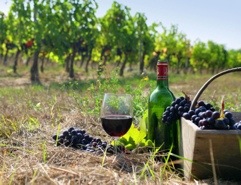
As a result of all of the evidence for global warming, there is an ever increasing environmental consciousness in consumers that is playing a more important role in their purchase decisions than ever before. These environmentally conscious purchase decisions are often based on how well the particular product satisfies their own needs, while minimizing any harmful effects on the environment. Some studies have shown that some environmentally conscious individuals are willing to pay more for a product, so long as is safe for the environment or very little harm was done to the environment while creating it.
Wine tourism is not except from the environmentally conscious mind. There are many potential damaging ecological impacts in the wine industry that those seeking a more environmentally friendly approach pay close attention to, including the farming, harvesting, winemaking, and travelling aspects of the industry. Studies have suggest that wine tourism is a way to connect with consumers, and that wineries must consider not only the winery or wine region, but also the consumer and a more sustainable consumption pattern.
An individual’s consumption patterns is often driven by convenience, habit, value, health concerns, and also one’s acceptance of established social norms. Some studies have found that demographics, including gender and education, can influence consumption and environmental behaviors, while others have found more mixed results. In general, those individuals that act in more environmentally friendly ways will often display these values by presenting a positive attitude toward ecologically friendly products, recycling, or being active in causes that aim to protect the environment.
Many behavioral and psychological studies have found that there is a direct relationship between attitude and behavior, and that strong attitudes toward a particular issue can predict behavior. In regards to the environment, studies have shown that attitude is a strong predictor of behavior when there is a positive attitude toward the performance of an environmentally friendly act. Thinking in terms of wine tourism, this could imply a positive attitude toward the environment would increase the likelihood of that individual purchasing an organic wine, or visiting a winery that touts strong environmentally-friendly practices.
Wine Tourism
Wine tourists are not “one size fits all”. There are many different kinds of wine tourists, which means that it is critical that wineries (or other businesses involved in the selling of wine) must specifically target consumers in a way that shows an understanding of their behavior, purchase intention, and purchase needs, which would ultimately increasing the effectiveness of their advertising approach.
Wine consumption has become increasingly popular in the United States, with consumption increasing between the years 2000 and 2005 by 31% for adults in households with incomes greater than $35,000/year. Very recently, it has been announced that the United States is now the #1 consumer of wine in the entire world, beating out France who previously held the title. This increase in consumption means that there are more consumers looking to purchase wines, therefore wineries and other businesses that sell wine need to tailor their advertising approaches to cater to these new consumers.
In relation to the environment, there are many wineries that have begun using organic or biodynamic approaches to grape growing and winemaking. However, even though these environmentally-friendly establishments exist, they mostly do not advertise this fact, which may be due to the fact that there is still the misconception that organic or biodynamic wines are lower in quality that wines produced in more conventional methods.
Environmental Consciousness and How it Relates to Demographics
An environmental tourist is one that is concerned about environmental issues, and seeks out products that are produced in a more environmentally friendly way. What defines an environmental tourist exactly is somewhat difficult, but some have speculated it can be broken down by examining several demographic variables, including gender, age, income, education, area of residence, environmental attitudes, and consumption patterns. Each variable taken alone does not appear to indicate whether or not an individual is likely an environmental tourist, however some combination of them may be more telling.
Wine tourists’ attitudes about the environment often plays a critical role in determining if they are environmental tourists, and what their purchase intention will be. It has been shown that demographics alone may not be enough to predict purchase intention related to environmentally sound products, but when combined with the attitude-behavior mechanism described earlier may give a strong indication of environmental purchase intention.
There are many different attitudes and behaviors that can influence purchase intention when it comes to environmentally-friendly products, however, that alone would take up another whole blog post. Focusing on just the gender demographic in particular, studies have shown that it can be a predictor of certain consumer attitudes. When it comes to environmental attitudes, the results are mixed. Some studies have shown that women tend to have less environmental knowledge than men, but are more emotionally involved with the cause and show more concern over the destruction of the environment, which indicate that women have stronger environmental attitudes (which translates to more environmentally-friendly behavior and purchase intentions). The theories behind this phenomena are under debate, but more studies seem to agree that it is a more biological and psychological mechanism than more external factors such as differing opportunities for men versus women.
There also seems to be an age effect in regards to environmental attitudes and behaviors. Though the results between studies have been mixed, many have shown that younger generations tend to have greater levels of knowledge about the environmental than older generations, and that younger generations tend to support environmental reform and readily accept pro-environmental decisions that their older counterparts.
Willingness to Pay/Purchase Intention
I’ve alluded to quite a bit already that positive environmental attitudes and behaviors often lead to action by way of higher purchase intention for products produced in an environmentally-friendly manner. One survey of U.S., British, and Australian tourists showed that 70% of them would pay upwards of $150 more for a 2-week stay in a hotel that maintained an environmentally-positive attitude. In regards to wine, a study found that 56% of consumers studied would be willing to pay a higher premium on wines that were considered environmentally friendly, compared to conventionally made wines. Another study found that study participates were willing to pay 18% more for environmentally friendly wines.
One Study’s Model Results
Taking all of these results (and many more not discussed here), one study created a model to test how environmental attitudes related to environmental behavior and thus purchase intention of wine. This model reflected the relationships between environmental involvement, environmental attitudes, and environmental behaviors as independent variables, as well as purchase intention as the dependent variable. The model was run both before and after taking gender into consideration.
Their results showed that wine tourists (depending on their demographics and personality) stated an intention to pay more for an environmentally-friendly wine, as well as to pay for an environmental fee to taste the wine or tour the wine region, the proceeds by which were allocated toward insuring the protection of the environment.
In regards to gender, the study found that men did not have strong relationship between environmental involvement and attitudes, whereas women did. On the other hand, the study found that men showed a very strong relationship between environmental involvement and behavior, whereas women did not. The study also found that women demonstrated strong relationships between environmental attitudes and behaviors, whereas men did not, which ultimately indicates that women are more likely to be more emotionally involved about environmental issues than men.
In regards to purchase intention, the study found that women showed a strong relationship between environmental behavior and purchase intention, as a result of their highly invested emotional attitude toward the environment. This result suggests that women are more affected by environmental issues than men, and are more willing to pay more for environmentally-friendly wines, as well as more willing to pay more to visit and protect a wine region.
Implications for Wine Marketing
The result of this and other studies indicate that wineries must be selective in their marketing approach to attract environmentally-conscious consumers. The results from the study mentioned previously showed how important it is to take demographics, income, and gender into consideration, as well as individual’s attitudes and behaviors toward the environment and subsequent purchase intentions. For wine consumers who are male, advertising messages should have less emphasis on emotion and more emphasis on knowledge-based information. This type of advertising for male consumers could be successful on wine labels, as well as through food or wine magazines. On the other hand, advertising for female consumers should be more emotion-based.
In order to change environmental attitudes, advertising campaigns should focus on the positive aspects of the product, and not the generalized negative aspects of the alternative. For example, when marketing an environmentally-friendly wine, advertisers should mention the specific dangers of pesticides and the problems of organic waste disposal in wine production, but not general global warming or waste management issues. Also, advertisers should mention how they are acting to help preserve the environment by producing their wines in a more organic/biodynamic, and overall environmentally-friendly manner.
Of course, there isn’t only one type of advertisement that will fit each and every wine consumer, thereby wineries and other businesses that sell wine must apply this environmental involvement, attitude, behavior, and purchase intention knowledge to create multiple advertising campaigns, in order to maximize the reach to wine consumers.
Thursday February 23rd, 2012
Posted in Blog, Latest News



